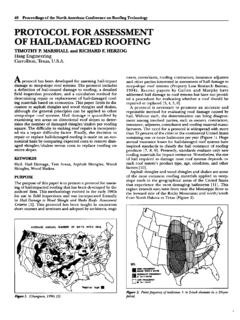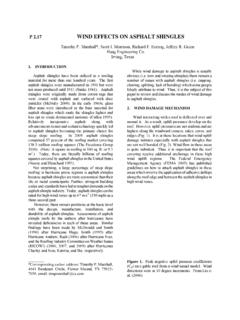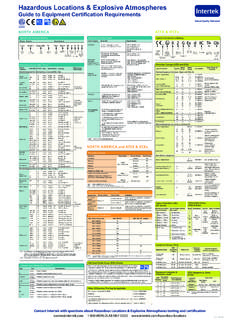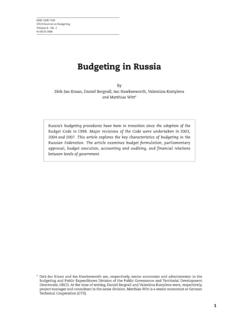Transcription of TOWER CRANE LIFE EXPECTANCY - Haag Global
1 TOWER CRANE life EXPECTANCY AN EXAMINATION OF RECENT TRENDS TO ESTABLISH AGE LIMITS Jim D. Wiethorn, Matthew R. Gardiner, Anthony E. Bond, Edward P. Cox, , PhD Ray A. King, TOWER CRANE life EXPECTANCY - Haag Engineering Co. January 5, 2015 1 TOWER CRANE life EXPECTANCY AN EXAMINATION OF RECENT TRENDS TO ESTABLISH AGE LIMITS Over the past decade there have been increased discussions and attempts around the world to set and/or legislate a maximum service life of TOWER cranes, and in some cases mobile cranes based solely on their age.
2 As a result of the recent publication CRANE Accidents: A Study of Causes and Trends to Create a Safer Work Environment, 1983-2013, Jim D. Wiethorn, , the Specialized Carriers and Riggers Association (SC&RA) approached Haag Engineering Co. to evaluate and compare the basis of these claims to our experience in CRANE accident analyses and CRANE Study results. SC&RA submitted questions which their membership wanted addressed that relate specifically relate to the ages of the cranes. As part of our analysis, we examined the CRANE Study results with respect to the CRANE ages at the time of the incidents to the actual causative factors of the accidents, with an emphasis on TOWER cranes.
3 Additionally, we researched and addressed a variety of issues raised in support of and rebuttal to proposals for regulations in various parts of the world. The purpose of this analysis was to determine if any correlation exists between CRANE accidents and ages of cranes, to evaluate whether basis for these claims would suggest an age limit for such equipment. HISTORICAL RESEARCH The earliest known policy to stipulate calendar ages of cranes as a limit to their service lives was enacted in Singapore during October 2006, although development of the regulation first began in April 2004.
4 The guidelines address imported TOWER cranes with both current registration and those seeking first time use in the country. The statutes governed the introduction of used TOWER cranes from other countries that met the following criteria. 1. First Time Use of A TOWER CRANE : Model and type-approved for use in Singapore and accompanied by a recent (not more than 2 years) inspection certificate from the statutory authority from the country it was used. Any TOWER CRANE not manufactured in Singapore that is 5 years or older shall be subjected to an inspection by a third-party inspection agency acceptable to the Commissioner for Workplace Safety and Health.
5 Used TOWER cranes are not permitted in Singapore if the unit is 1) from a country that does not have requirements on statutory inspection; 2) the CRANE is 15 years or older (date of manufacture); 3) or the TOWER CRANE has an inspection certificate from a country that was last issued more than 2 years ago. TOWER CRANE life EXPECTANCY - Haag Engineering Co. January 5, 2015 2 2. Existing TOWER CRANE Certificates: A TOWER CRANE not manufactured in Singapore whose existing certificate is 8 or more years old shall undergo a third-party inspection before each installation.
6 If the TOWER CRANE is 15 years or older, it will not be allowed to be used unless the owner obtained a letter from the manufacturer certifying that the CRANE can be safely used for a longer period of time. TOWER cranes 20 years or older will not be allowed for use. Non-destructive tests shall be carried out by an accredited testing company in accordance with the Singapore Accreditation Council, SINGLAS (Singapore Laboratory Accreditation Scheme) guidelines for the particular scope of testing. Other requirements include a CRANE layout plan (clearly showing zones of influence) in conjunction with AE (Architect/Engineer) certification that the CRANE was erected in accordance with the plan; confirmation that the CRANE operator is registered and that the lift supervisor, riggers, and signalmen have approved zones of operations.
7 Further, all personnel so noted are required to sign the plans confirming clear understanding of their responsibilities. Additional guidelines include a requirement that all foundations and braces be designed and their installation is confirmed by a professional engineer. The professional engineer also must confirm that the TOWER CRANE was installed/erected in accordance with plans. In 2007 Mr. Dale Curtis, , submitted a petition to Cal/OSHA recommending a change to Section 4884 of the GISO (General Industry Safety Orders), amending it to require that all hammerhead and luffing TOWER cranes older than 20 years not be climbed and/or tied to any structure.
8 Furthermore, he also proposed that cranes older than 20 years be used only as freestanding TOWER cranes and that any TOWER CRANE older than 30 years not be used on construction sites. Mr. Curtis cited the following problems as being common to older TOWER cranes: 1. Operating manuals for older TOWER cranes are often incomplete and do not show accurate values for foundation reaction forces and other forces needed for the engineer to design struts to tie-in to the adjacent structure. 2. The manufacturer s technical and service bulletins are often not included in the operation manual.
9 3. Technical support may be unavailable if the manufacturer is no longer in business. 4. The CRANE owner is not always able to furnish a competent technician for either climbing or dismantling the CRANE . The CRANE user/contractor may therefore have to locate a competent technician elsewhere. TOWER CRANE life EXPECTANCY - Haag Engineering Co. January 5, 2015 3 5. The CRANE owner may not have high-wear original equipment manufacturer (OEM) replacement parts readily available. Thus, questionable material and salvage parts may be used to replace worn-out parts.
10 6. Owners of some older TOWER cranes write bare-rental contracts in which the CRANE user (contractor) assumes responsibility and liability for on-going maintenance, engineering for tie-in struts, climbing and dismantling expenses. Some CRANE users do not or are not financially able to take-on these responsibilities. 7. Almost all TOWER cranes which are climbed/raised to higher configurations are subsequently tied-in to the adjacent structure. Tie-in collars for old cranes often appear to be worn out and without new connection components.















